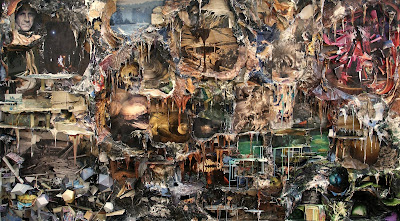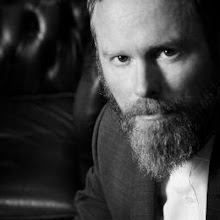THE ORDER OF THINGS
Paul Eachus,
Chris Jones, Alexis Milne, David Turley
Private View
Friday March 1st
6.30-8.30pm
Performance
Friday March 1st
7.30-8.00pm | The Cult of Rammelzee (Alexis Milne, Jezza Ho, Luke Mozes, Tex
Royale)
Exhibition
Dates
Saturday March 2nd
– Saturday March 30th 2013
Gallery Hours
Wednesday–Saturday 11am–6pm or by appointment
A
perambulator wheel, wire-netting, string and cotton wool are factors having
equal rights with paint. The artist creates through choice, distribution and
metamorphosis of the materials.
Kurt Schwitters, Der Sturm, 1919
The advent of collage and assemblage was
arguably one of the most important developments in 20th century
Modernism that led to the multiplicitous explosion of Postmodernism and current
art practice. It has fundamentally influenced the nature of making and the use
of materials since 1912 to the current day, from Picasso to Schwitters to
Rauschenberg to Barbara Kruger, George Barber and recent Turner Prize winners Mark
Wallinger and Elizabeth Price. The embracing of ‘low’, found and acquired
materials and images was and is a method that elevates the process in itself as
equal to the consideration of the final object. This enables the artist to
appropriate from existing sources, thereby rendering the whole of culture,
manufacturing and commerce as legitimate and direct source material.
This suggests an element of collaboration, or
at least shared authorship, between artist and the originator of materials. The
artist is in a sense curating his or her own works by researching, selecting,
collating, appropriating and combining. Evident in the four artists featured in
The Order of Things, they each employ
similar drives to make manifestly different types of work. Similarly, the show
as a whole can be seen as a collaborative artwork in itself, with dialogues between
gallery director and artists allowing in places the former to influence the latter
and vice versa.
Paul
Eachus
primarily makes photographs of constructions that he has assembled in his
studio. By collecting various objects and arranging them specifically into
conflicting fragmented narratives he forces a reinterpretation of things.
Eachus takes from the real world and orders objects and situations that might
otherwise be unrelated, and overloads the studio scene with obsessive
repetition. The spectator is then denied first-hand experience of this set of
events by being presented with a photograph rather than the installation
itself, suggesting a desire to indicate information whilst preventing full
disclosure. The process is revealed but the meaning of the constituent parts is
not.
Chris
Jones
is also concerned with the fragmentation of assorted references, where multiple
parts are collected, rearranged and reinterpreted. The Design of Pursuit is a large scale wall mounted collage. Images
and form vie with each other to create a whole where we are uncertain of what
is secondarily sourced and what is hand manipulated by the artist. Extraneous
information is allowed to leak and merge until one part of the work infects the
other. Referring to the interior of a cave where stalactites encumber the
picture plane, The Design of Pursuit
is a dynamic and complex piece that asks us to consider the correlation between
the natural and man-made, and subsequently how we assimilate and process
received information. There is a strong suggestion of the archaeological, both
visually and figuratively, but equally we might be looking at a melting section
of an obsessive’s information board.
Alexis Milne combines video, installation and performance to
investigate the roots of subcultural uprising, most recently that of Hip Hop
culture. The Order of Things will
feature a version of Your Eyes are Dead,
which was recently exhibited at the International Film Festival Rotterdam in
conjunction with Joey Ramone Gallery. Your
Eyes are Dead utilises sampled and cut-up imagery to make a ritualistic
meditation on the adverse urban conditions that enabled graffiti and B-Boy
subcultures to take root and thrive. Collaging his own performance The Westway (featuring the Cult of
Rammellzee), which pays homage to the first graffiti piece in London by New
York’s Futura 2000; footage of Robert Moses’ Cross Bronx Expressway; and cult
films that feature the South Bronx as a dystopian backdrop including Wolfen, Stations of the Elevated and Wildstyle,
Milne presents an oblique investigation into the story of Hip Hop and the
artist’s own relationship with it.
David Turley makes something closer to assemblage, where the collection or acquisition of the component parts is paramount to the creation of the final piece. Turley embraces the notion of chance, where unexpected meetings, dialogues or found / collected objects might lead him to the extent of moving countries in order to complete a work. Intrinsic to this process is a sense of unfolding narrative, where events and artist prompt and respond accordingly. Themes including memory, lost histories, religious ceremony and compulsion underpin his work, as initially disconnected acts, places and objects are combined to reveal underlying or unexpected interconnections.
David Turley makes something closer to assemblage, where the collection or acquisition of the component parts is paramount to the creation of the final piece. Turley embraces the notion of chance, where unexpected meetings, dialogues or found / collected objects might lead him to the extent of moving countries in order to complete a work. Intrinsic to this process is a sense of unfolding narrative, where events and artist prompt and respond accordingly. Themes including memory, lost histories, religious ceremony and compulsion underpin his work, as initially disconnected acts, places and objects are combined to reveal underlying or unexpected interconnections.
 |
| Paul Eachus The Time is Right, 2012 C-type print, diasec mount 77x91cm |
 |
| Paul Eachus Trans Chaosmos Facility 21 Photograph, felt tip, pencil, charcoal, ink on Somerset paper 29.5x21cm |
 |
| Chris Jones The Design of Pursuit, 2013 Magazine & book images, board, paper 126x226x8cm |
.jpg) |
| Alexis Milne Your Eyes are Dead, 2013 Video installation (13.40 mins) |
 |
| David Turley October 1966, 2013 35mm slide Dimensions variable |








.jpg)
No comments:
Post a Comment